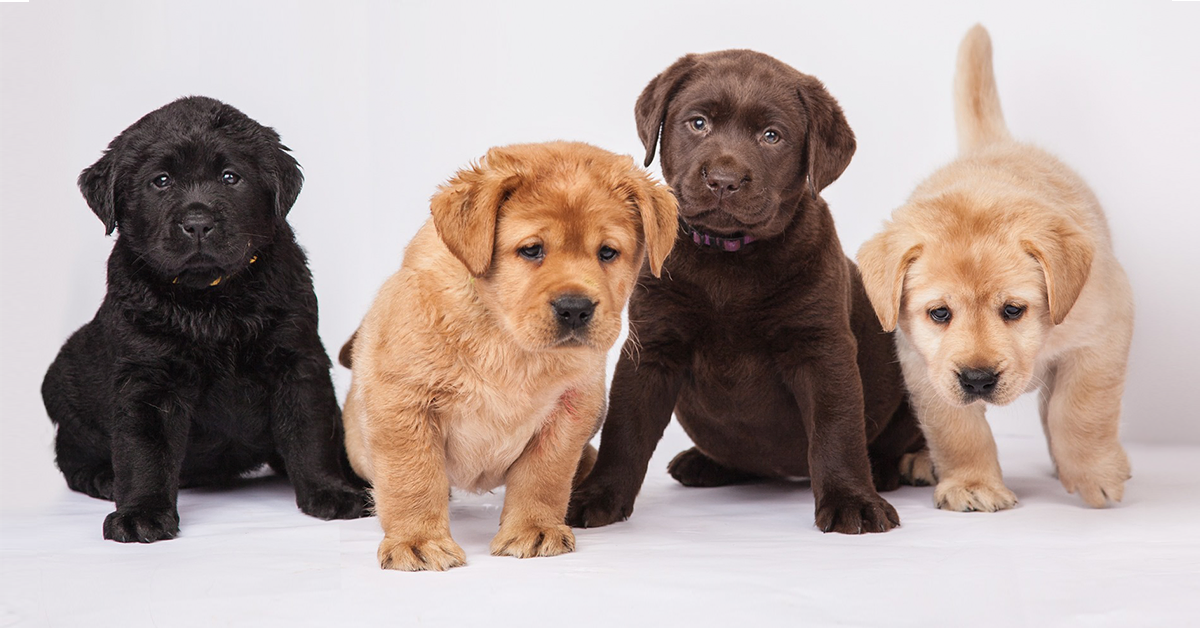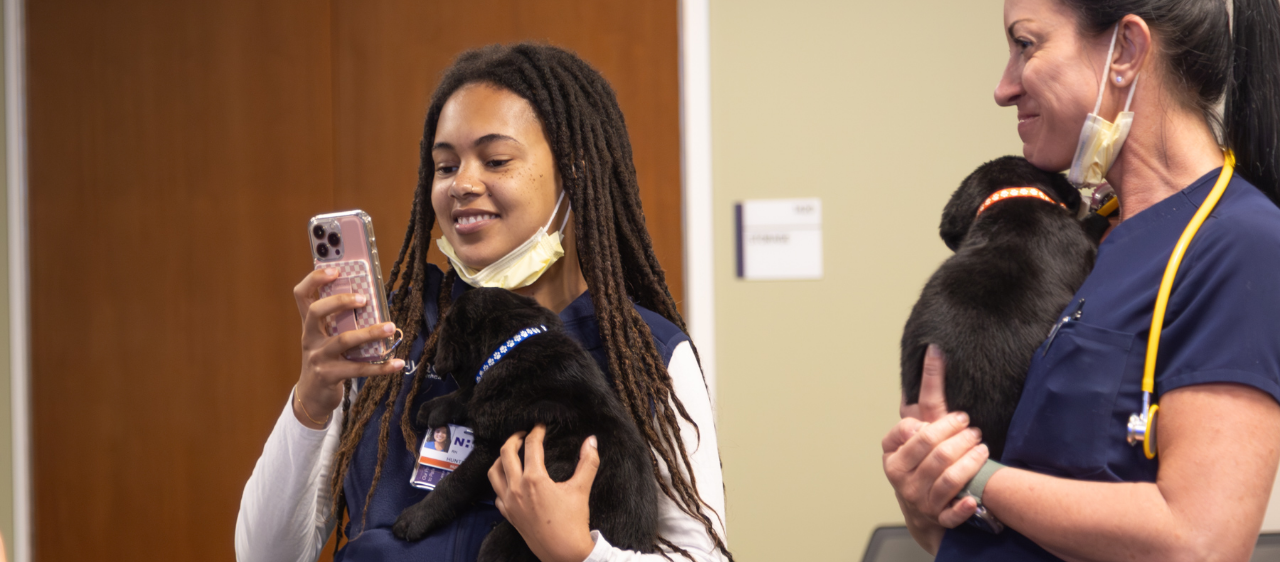
Project 2 Heal
When it comes to coat color of Labrador puppies, there are three colors recognized by the American Kennel Club. Black, yellow, and chocolate are the three varieties of Labrador Retriever coat colors, however these puppies often exhibit different shades of black, yellow, and brown fur.
What Causes Coat Color Variation?
Genetic information for Labrador puppies is autosomal, meaning all labs receive this information from parents in a way that’s unrelated to the sex of the puppy. Where it begins to get tricky is when we discuss the genetics of black and chocolate puppies when compared to yellow puppies.
Puppy Genes and Alleles:
Before we go any further, let’s rewind to high school biology with a few key definitions:
-
Gene: The basic unit of heredity that occupies a specific location on a chromosome.
-
Allele: One of two or more versions of a gene.
When it comes to the coats of Labrador puppies, fur color is determined by one of two different genes, as well as a variety of alleles.
How Do We Get Black and Chocolate Labs?

When it comes to black lab puppies and chocolate lab puppies, both varieties inherit their fur color from a single gene, known as "Tyrosinase-related protein 1.” (TYRP1, as it’s commonly known.) This gene can present with one of four alleles, one dominate allele coding for black fur we’ll refer to it as “B”) and three recessive alleles coding for chocolate fur (which we’ll refer to as “b”).
To better understand, let’s take a look at the following scenarios:
-
BB. Here we have two dominant genes for black fur, obviously resulting in a black lab puppy.
-
Bb. In a situation in which either parent passes on the dominant allele and the other passes on the recessive, the lab puppy will still have a black coat.
-
bb. When both parents pass on the recessive allele, only then do we see a chocolate lab puppy.
How Do We Get Yellow Puppies?
Yellow Labrador puppies get their hair color from a gene entirely different from the gene that determines black or brown fur. But, that doesn’t mean yellow lab puppies don’t have the TYRP1 gene we talked about above—there’s a different gene that can override alleles at TYRP1 coding for black or chocolate puppies.
Melanocortin 1 receptor (MC1R) is the gene responsible for yellow lab puppies, but can still result in fur coats of black and brown. The three most common alleles at the MC1R gene are “E” (which still produces black and brown fur) and “e” (which produces yellow fur).
As mentioned in the video above, the allele for yellow lab puppies is recessive. We'll dive a bit deeper here with a couple of scenarios:
-
EE. Both parents pass on dominant alleles for black or chocolate fur, resulting in a black or chocolate puppy.
-
Ee. One parent passes on a dominant allele for black/chocolate, while the other passes on the recessive allele for yellow fur.
-
ee. Only in a situation in which both parents pass on alleles coding for yellow fur is the TYRP1 gene overridden and yellow lab puppies are produced.
What is also interesting about the creation of yellow lab puppies is the fact that while their fur coat is without black or brown pigment, their skin will still exhibit the same color pigment as that of black or chocolate lab puppies.
Evaluating Our Foster Litter of Rescue Puppies:
Rescue Puppies Take Volhard Puppy Aptitude Test!

Where Does Project 2 Heal Come In?
At Project 2 Heal, we breed Labrador Retriever puppies for the purpose of donating these animals at 8 to 12 weeks of age to one of our partner organizations. From there, our puppies are trained extensively in service dog work and matched with an individual in need.
Our process begins with Early Neurological Stimulation, which are exercises conducted during the first two weeks of life—beginning at only 48 hours after birth!—that slightly stress the puppy's nervous system and allow them to become less reactive to novel stimuli as adults. This process includes the following:
-
Tactile stimulation: Stimulating puppy paws through touch our tickling.
-
Holding the head of the puppy erect.
-
Holding the head of the puppy pointed downward.
-
Supine position: Resting the puppy on its back in the palm of hands.
-
Thermal Stimulation: Placing feet of puppy on top of a cool, damp towel and allowing the puppy to move about.
Service Dog Scent Training:
Also occurring during the first 14 days, service dog training includes a process called early scent introduction. This training exposes dogs to smells it will encounter during working life. During this process, trainers pay close attention to the way puppies react to various smells. This helps identify which puppies may not be suited to work as a service dog.
Service Dog Clicker Training:
Championed by Karen Prior Academy, clicker training service dogs is a method that teaches puppies about associations. Puppies learn commands through a combination of rewards and clicking sounds. During service dog training, high-level tasks are broken into smaller tasks, after which puppies are rewarded with food and stimulated with sound from a handheld clicker.
Eventually food and clicking sounds are phased out so that puppies are able to execute tasks upon command.

You Can Heal a Veteran & Honor a Loved One.
It can take up to 4 years and between $25,000—$40,000 to provide a life-changing service dog to a veteran struggling with PTSD or loss of limb. But it doesn't have to be this way. Project 2 Heal is a nonprofit working to reduce the cost and time needed to provide a service dog to someone in need. We accomplish this by breeding, nurturing, and donating world-class Labrador Retriever puppies to become service dogs for veterans, children with special needs, or adults with disabilities.
By joining our Healing Pawtners, you have the chance to dedicate every donation you make to honor a loved one. Your monthly contribution of $10, $30, or $50 will provide a consistent and reliable source of funding to help us meet our mission. Your support will help nurture our puppies' growth and development, as we prepare them to literally change lives as future service dogs. To show our appreciation for your support, you'll receive:
-
Opportunity to honor a loved one through your charitable giving.
-
One "paw-tograph" from a Project 2 Heal puppy.
-
Professional family photo of each Project 2 Heal litter of future service dogs.
-
Access to visits with future service dogs at the Project 2 Heal facility.
-
Updates on puppy progress as our puppies are donated to service dog partner organizations.
-
"Healing Pawtners" car magnet to proudly display.












Post a comment